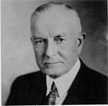Thomas J. Watson, Sr.
Born February 17, 1874, Campbell, N. Y; died 1956; the towering figure whose lengthening shadow was IBM, which he reluctantly allowed to be dragged from punched cards to computing,- creator of IBM's motto "Think."

Education: Addison Academy, New York; School of Commerce, Elmira, NY
Professional Experience: salesman, pianos and sewing machines, Painted Post, NY, 1892-1896; salesman to general sales manager, National Cash Register (NCR) Corp., Dayton, Ohio, 1896--1914; general manager to chief executive officer, Computing-Tabulating-Recording Corp., 1914-1924; chief executive officer to president, IBM Corp., 1924-1956.
Thomas J. Watson, Sr., is one of those figures in the history of computing whose contributions are by no means technological but without whom the technologists would not have been able to proceed. After his somewhat controversial stint as general manager with the National Cash Register Corp., and the subsequent growth of IBM out of the Computing-Tabulating-Recording Corporation, Watson set the stage for the introduction of the computer in the corporation.
The first step was the construction of the Harvard Mark I calculator designed by Howard Aiken. IBM was selected as the "prime contractor" company but also had to provide expertise and experience from its card processing and unit record business to supplement Aiken's ideas and to complete the project. At the dedication ceremony Aiken snubbed Watson and IBM's contributions, and a never-to-be-mended rift developed between the two men. [See biography of Howard Aiken.] Although Columbia University had been influential in its promotion of mechanical computing systems in the T.J. Watson Astronomical Computing Bureau, IBM had never taken advantage of this expertise to move into the computer business. [See biography of Wallace Eckert.] Subsequently IBM constructed the Selective Sequence Electronic Computer (SSEC) machine, installed it in its headquarters on Madison Avenue, New York, and opened a service bureau to provide computing utilities to the public. The Korean War provided an impetus to allow IBM to show its nationalistic pride by offering to build a "Defense Calculator" to serve the war effort. This machine, later designated as the Type 701 machine, became the first of the two major series of mainframe computers central to its success.
Watson, Sr., has been labeled as having been reluctant to depart from the business that had stood him in good stead for almost 40 years and to commit the corporation to build electronic computers. By the time that this opportunity was being pressed on him, Watson, Sr. was relying more and more on the judgment and advice of his eldest son to make decisions. But the stage was set, the line of succession was established, and the technology was ready. Watson had contributed the environment within which the commercialization and marketing of the computer constituted a profitable venture. Throughout Watson's career he had profited from the "waiting game," although rarely the first to introduce a new product, he was able to build on the experience of others. He did it with the computer; his son did it with System/360; the company did it with the personal computer.
QUOTATION
"I think there's a world market for about five computers." (Attr. [1943] -probably apocryphal)
BIBLIOGRAPHY
Biographical
Hurd, Cuthbert, "Early IBM Computers: Edited Testimony," Ann. Hist. Comp., Vol. 3. No. 1, 1981, pp. 163-182.
Slater, Robert, Portraits in Silicon, MIT Press, Cambridge, Mass., 1987.
Watson, Jr., Thomas J., and Peter Petre, Father, Son & Co, Bantam Books, New York, 1990.
UPDATES
Portrait added (MRW, 2013)
New content Copyright © 2013-2023 by the IEEE Computer Society and the Institute of Electrical and Electronics Engineers Inc.
All rights reserved. This material may not be reproduced or redistributed without the express written permission of the copyright holder.
